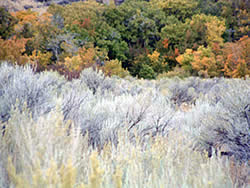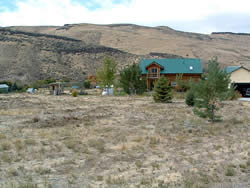
National Fire Plan Success Story
Big Goals Being Met Through Communities at Risk and Hazardous Fuels Projects in South Central Idaho
National Fire Plan - Fuels Reduction
Having suppressed nearly 700,000 acres during this past wildfire season of 2007, the Idaho Bureau of Land Management Twin Falls District Fire and Aviation Program is certainly not at rest during these cooler fall months. Fall signals a massive surge in the efforts of the fuels and rehabilitation programs. This fall, the Twin Falls District is completing nine Communities at Risk and Hazardous Fuels projects in an effort to achieve some big goals that could help prevent such a significant fire season in the future.
Communities at Risk (CAR) projects in south central Idaho are done through Mid Snake Resource Conservation and Development (RC&D). This organization is the grantor of funds allotted to the BLM through the National Fire Plan to complete CAR projects. The two agencies operate under a cooperative agreement that allows the RC&D to conduct fuels, prevention, and mitigation projects on private land that the BLM could not otherwise treat. This collaboration is crucial given that all CAR projects are completed on private land. The partnership between the BLM and RC&D is strong as the two are constantly working together to protect local communities from the threat of wildfire.
Among the CAR projects being completed within the Twin Falls District this fall, is an 80 acre re-seeding effort in an area west of Shoshone. The private land being treated is located adjacent to public land and has no defensible space. While the goal of such efforts is to help communities and protect homes, there is also another benefit.
"Too often public land burns up because we have to dedicate our resources to protecting structures," Twin Falls District BLM Fuels Specialist Brandon Brown says. "Doing a project such as this will reduce the threat to private property and ultimately allow us to focus on protecting public land."
Another such project is being done in the Big Little Ranches subdivision of Jerome. This past summer, a wildfire in the area threatened multiple houses and caused significant traffic hazards and delays. 120 acres of the area is being re-seeded to a more firewise vegetation, perennial grasses and forbs that won't have to be irrigated, but slow the progress and decrease the looming threat of a wildfire.
"Using perennial grasses and forbs allows the area to be greener longer and breaks up the fuel continuity," Brown indicates.

Brush in the Rock Creek area south of Twin Falls was thick and created a fire danger for area residents.

An 80 acre fuels reduction project in the Rock Creek area created 150-foot buffer strips, greatly reducing risk to homeowners.
Another 40 acres has already been treated at Rock Creek south of Twin Falls. Brush was mechanically removed on private land that is again adjacent to public land. One goal of this project was to specifically improve the road and the access to the landowner's homes. The one-way, dead end lane was originally very narrow and fully lined with bushes and trees. Before the project, in the event of a wildfire, there would be no way the homes could have been saved. The brush was cleaned up and a fuel break provided.
Another goal of the Rock Creek project was to protect the adjacent public land in the area. This particular spot is an area with high resource value, including healthy sage grouse habitat. Protecting this area from a wildfire that could spread from private land was needed and accomplished.
Idaho BLM Twin Falls District Fire and Aviation Program is also working on various Hazardous Fuels efforts. A 2,500 acre broadcast burn was recently completed on the Kimama allotment within the Shoshone Field Office, with the goal of removing annual cheat grass. Impressively, this burn ties in to more than 15,000 acres of treatments that have been done in the Kimama allotment in the past eight years.
In 2000, Fire Use Specialist Joe Russell planned out nearly a decade worth of treatments for this particular area. The land surrounding the Kimama allotment is healthy sage grouse habitat and contains more native vegetation. Kimama, however, was dominated by exotic annual plant communities that lead to increased fire hazard. An aggressive and long term project was created to increase usable space for sage grouse and minimize the fire threat in the area.
The proposed total acreage of the Kimama allotment project was 20,000 acres, a feat which clearly had to be undertaken in phases. This recent burn in 2007 is the final piece to the overall puzzle and will be seeded in the spring.
Already the project has seen a degree of success. Within the past eight years, one fire has burned through the first treatment area. The blaze began to the east and quickly burned into the treatment area. Once the flames connected with the newer native fuels, the fire slowed significantly and quickly died out.
"It was exactly what we wanted to have happen," Russell exclaims. "After the fire, we allowed the area to recover naturally and it did great. This makes it so we don't have to spend any more money on these treated areas."
Another notable hazardous fuels project being completed in the Twin Falls District this fall is located in Martin Canyon near Bellevue. A 100 acre aspen thinning effort follows a recently finished commercial logging operation. This project is also a long term effort, having begun in 2001 and set to be finalized with a prescribed burn next spring.
The fuels work that has been and is being done is only the beginning for the Twin Falls District Fire and Aviation Program. Upcoming efforts include the planting of 50,000 sagebrush and bitterbrush seedlings. They are hand planted in the fall and spring months by both BLM fire crew members and volunteers with the Idaho Department of Fish and Game, whom are also involved in project planning. The seedlings will be planted within the Craters of the Moon National Monument, the Jim Sage area of the Burley Field Office and in the Jarbidge Desert.
Another upcoming effort is a 215 acre mechanical thinning that will be completed at Cougar Point within the Jarbidge Field Office. The area is littered with Aspen and Mountain Mahogany that are encroaching into sensitive species habitat. The goal of this effort will be to reduce fuel loading in the area.
Whatever the goal may be and the effort involved to make it happen, the Twin Falls District Fire and Aviation Program is clearly busy making positive things happen.
Contact: Brandon Brown, 208 732-7218